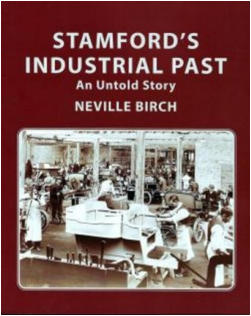Stamford's Industrial Past -
An untold story
By Neville Birch
Society for Lincolnshire History and Archaeology, 2021
172pages. Paperback. ISBN 9780903582629
In
1972,
Neville
Birch
produced
'Stamford
-
an
Industrial
History'
for
the
then
Lincolnshire
Industrial
Archaeology
group.
It
was
a
reproduced
typescript
with
a
few
illustrations
but
a
worthwhile
publication
of
great
interest
to
anyone
concerned
with
the
town
or
its
environs.
Chris
Lester
has
rewritten
and
vastly
expanded
it
with
copious
black
and
white
and
colour
illustrations
into
a
remarkable
publication
of
great
quality.
Unfortunately,
he
didn't
live
to
see
its publication.
Starting
with
building
and
construction,
the
book
moves
through
milling,
brewing
and
malting
into
textiles
and
plastics
as
well
as
a
considerable
section
on
the
engineering
and
manufacturing
which
Stamford
is
famous
for.
Space
is
found
for
a
description
of
public
services,
railways
and
transport
as
well
as
printing
and
publishing
before
concluding
remarks
on
the
effects
of
war
on
the
Stamford
area.
The
book
is
indexed
with
a
bibliography
although
much of the content is down to original research by Neville Birch and Chris Lester.
There
are
many
businesses
trades
and
industries
mentioned
in
the
book
and
it
is
highly
recommended
to
anyone
with
an
interest
in
local
history
as
Stamford
and
its
industry
had
such an impact on the local area.
Chris
Lester
says
in
his
conclusion:
'Behind
the
popular
image
of
an
attractive
town
whose
architecture
has
become
a
magnet
for
tourists
lies
an
illustrious
history
in
engineering,
manufacturing,
extractive
industries
and
transportation
facilities.
Several
firms
achieved
international
fame
and
many
more
were
nationally
known
for
the
quality
and
innovative
nature
of
their
products.
One
of
the
notable
aspects
of
the
book
is
that
it
brings
to
light
a
succession
of
remarkable
local
men
and
their
enterprises.
They
created
employment
and
wealth
which
helped
to
make
Stamford
what
we
see
today
and
today's
employment
and
the
towns future are built upon it.'
Dr Hilary Crowden

Researching Rutland
Copyright © Rutland Local History and Record Society. - All rights reserved
Registered Charity No 700273


Book Review



Researching Rutland
© Rutland Local History and Record Society
Registered Charity No 700273

Book Review
William Browne’s Town: The Stamford Hall Book 1465-1492
Stamford Survey Group in association with Stamford Town Council and
Stamford Civic Trust
Stamford is fortunate to have a Hall Book, a record of the council minutes
of the town. Until now it has remained in the town’s archives only to be
seen by historians with an appointment. With this transcript Alan Rogers
has made the first part of the Hall Book accessible to all and we are given
the opportunity to step back in time and discover what life was really like
in the fifteenth century. Future volumes are planned which will continue
the story of Stamford’s town affairs.
The book gives a remarkable insight into the lives of townspeople in
medieval England covering the years from 1465, shortly after the town’s
incorporation, until 1489 just after the death of William Browne. William
Browne was a very rich and important Merchant of the Staple. He
controlled the affairs of the town during this period, serving as Alderman
on several occasions. His legacy to Stamford is All Saints’ Church and
Browne’s Hospital.
As today, rules and regulations governed the lives of townsfolk. The
minutes record laws forbidding Sunday trading and fines for leaving
horses tied up in the wrong places on market days – as the editor
comments, ‘There were parking penalties even in medieval Stamford’. We
also find that there were designated places for dunghills and times when
animals could be brought into town. From this book we learn how law
and order was enforced and the punishments meted out to wrongdoers.
Perhaps the most interesting aspect of the volume is the tremendous
number of different trades pursued in the town. The wardens strictly
controlled the craftsmen to ensure the quality of goods and there was a
diversity of rules governing the guilds and the pageant of Corpus Christi.
Alan Rogers has had close links with Stamford and readers will no doubt
be familiar with his books The Medieval Buildings of Stamford
(Nottingham 1970), The Book of Stamford (Buckingham 1983) and, with
JS Hartley, The Religious Foundations of Medieval Stamford
(Nottingham 1974). He has also been closely involved with local history in
Rutland, most recently in Uppingham, inspiring and encouraging local
historians to record aspects of the history of that town.
For this volume Professor Rogers has written an excellent introduction
including the insight he has gained about the role of William Browne in
making the transcript. He also adds useful comments throughout the
volume and there is an excellent index. It is a shame that the Editorial
Conventions are not at the front of the book and a glossary would have
been useful for those less familiar with the legal terms of the medieval
period. Do not however be deterred by the plain cover: inside it is a
fascinating record not just for people in Stamford but for anyone
interested in town life in the Middle Ages. It is a book to dip into, and read
aloud it comes to life. It certainly merits a place on the bookshelf of
anyone interested in history.
Jean Orpin







